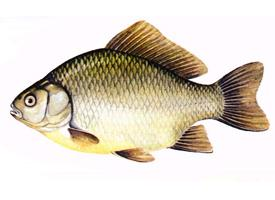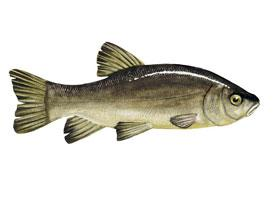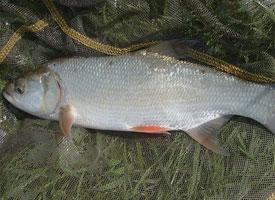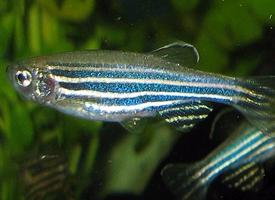
Váhy a míry
| Délka | 45 cm |
|---|
Biologická data
| Délka života | 10 r |
|---|
Popis zvířete
The Crucian carp (Carassius carassius) is a captivating species of freshwater fish that belongs to the family Cyprinidae, which is known for encompassing various other carps and minnows. This species is distinguished by its remarkable ability to thrive in environments ranging from small ponds to large lakes and slow-moving rivers across Europe and parts of Asia. The Crucian carp is a testament to the adaptability and resilience of nature, as it can survive in conditions that are less than ideal for many other fish species, including low oxygen levels and brackish waters.Physically, the Crucian carp presents a robust and somewhat deep-bodied appearance, with a broad and rounded shape that is designed for a life spent in the slower-moving waters of its preferred habitats. Adults can vary significantly in size, typically ranging from 15 to 25 centimeters in length, although specimens exceeding 30 centimeters have been recorded. The body of the Crucian carp is covered in large, shiny scales that can range in color from golden brown to a more subdued olive, often with a slight metallic sheen that makes them particularly striking under the sunlight. The belly is usually a lighter silver or yellowish hue, creating a pleasing contrast with the darker back and sides.
One of the most distinctive features of the Crucian carp is its lack of barbels, which differentiates it from some of its close relatives within the carp family. It has a small mouth and a broad, slightly convex forehead. The fins are generally a reddish or orange tint, adding a splash of color to its otherwise earth-toned body. The dorsal fin is long and almost straight, while the caudal (tail) fin is deeply forked, aiding in its navigation through the water.
Crucian carps are known for their incredible tolerance to environmental stressors. They can survive in waters with extremely low oxygen levels, thanks in part to their ability to metabolize anaerobically (without oxygen) and their behavior of gulping air from the water surface. Additionally, they have been known to endure periods of drought by burrowing into the mud and entering a state of reduced metabolic activity, a form of estivation.
In terms of diet, the Crucian carp is an opportunistic feeder, consuming a wide variety of available food sources. Its diet primarily consists of plant material, detritus, small invertebrates, and zooplankton. This adaptability in feeding habits further underscores its ability to thrive in a variety of conditions.
Reproduction for the Crucian carp typically occurs during the spring and early summer when water temperatures rise. They are known for their prolific breeding, with females capable of laying thousands of eggs which are then fertilized externally by the males. The eggs are usually deposited on submerged vegetation, where they remain until hatching.
The Crucian carp plays a significant role in its ecosystem, serving as both a predator of smaller organisms and a prey item for larger fish, birds, and mammals. Despite its resilience, the species faces threats from habitat destruction, pollution, and particularly competition and hybridization with introduced carp species, which can dilute the genetic purity of native populations.
In conclusion, the Crucian carp is a fascinating species that embodies the remarkable adaptability of freshwater fish. Its resilience in the face of environmental challenges, combined with its distinctive physical characteristics, makes it a noteworthy subject of study and appreciation among naturalists and anglers alike.
Nové fotografie zvířat
Top 10 zvířat
- Elephant hawk moth (Deilephila elpenor)
- Common house mosquito (Culex pipiens)
- Wasp spider (Argiope bruennichi)
- Fruit fly (Drosophila melanogaster)
- Australian box jelly (Chironex fleckeri)
- Common cockchafer (Melolontha melolontha)
- Colossal squid (Mesonychoteuthis hamiltoni)
- Moustached guenon (Cercopithecus cephus)
- Diana monkey (Cercopithecus diana)
- Bee hummingbird (Mellisuga helenae)


